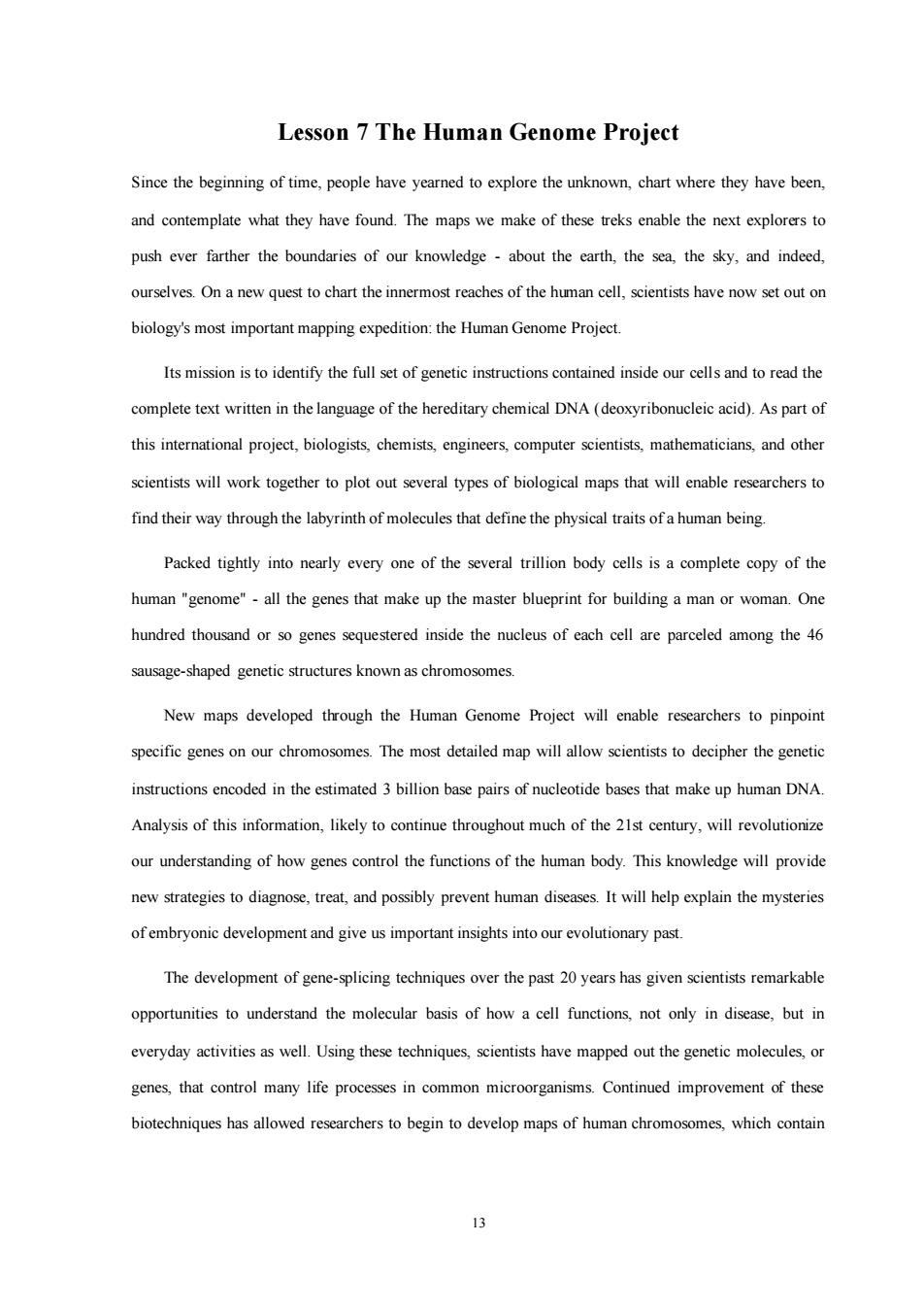正在加载图片...

Lesson 7 The Human Genome Project Since the beginning of time,people have yearned to explore the unknown,chart where they have been and contemplate what they have found.The maps we make of these treks enable the next explorers to push ever farther the boundaries of our knowledgeabout the earth,the sea the y and indeed, ourselves On a new quest to chart the innermost reaches of the human cell.scientists have now setouton biologys most important mapping expedition:the Human Genome Project Its mission is to identify the full s of genetic instructions contained inside our cells and to read the complete text written in the language of the hereditary chemical DNA (deoxyribonuclic acid).As part of this international project biologists.chemistsengneers computer sentistsmathematicians.and other scientists will work together to plot types of maps that will findtheir way through the labyrinth of mocu that define the physical traits ofa human being Packed tightly into nearly every one of the several trillion body cells is a complete copy of the human"genome"-all the genes that make up the master blueprint for building a man or woman.One hundred thousand or so genes squestred inside the nucleus of each cell are parceled among the 46 sausage-shaped genetic structures known as chromosomes New maps developed through the Human Genome Project will enable researchers to pinpoint specific genes on our chromosomes.The most detailed map will allow scientists to decipher the genetic instructions encoded in the estimated 3 billion base pairs of nucleotide bases that make up human DNA Analysis of this information,likely of,wil ourunderstanding of how genes con the functions of the human body.This knowledge will provide new strategies to diagnose,treat,and possibly prevent human diseases.It will help explain the mysteries of embryonic development and give us important insights intoour volutionary past. The development of gene-splicing techniquesover the past 20years has given scientists remarkable opportunities to understand the molecuar basis of how a cel functions,not only in disse,but in everyday activities as well.Using these techniques.scientists have mapped out the genetic moleculesor genes,that contro many life processes in common microorganisms.Continued improvement of these biotechniques has allowed researchers to begin to develop maps of human chromosomes,which contain13 Lesson 7 The Human Genome Project Since the beginning of time, people have yearned to explore the unknown, chart where they have been, and contemplate what they have found. The maps we make of these treks enable the next explorers to push ever farther the boundaries of our knowledge - about the earth, the sea, the sky, and indeed, ourselves. On a new quest to chart the innermost reaches of the human cell, scientists have now set out on biology's most important mapping expedition: the Human Genome Project. Its mission is to identify the full set of genetic instructions contained inside our cells and to read the complete text written in the language of the hereditary chemical DNA (deoxyribonucleic acid). As part of this international project, biologists, chemists, engineers, computer scientists, mathematicians, and other scientists will work together to plot out several types of biological maps that will enable researchers to find their way through the labyrinth of molecules that define the physical traits of a human being. Packed tightly into nearly every one of the several trillion body cells is a complete copy of the human "genome" - all the genes that make up the master blueprint for building a man or woman. One hundred thousand or so genes sequestered inside the nucleus of each cell are parceled among the 46 sausage-shaped genetic structures known as chromosomes. New maps developed through the Human Genome Project will enable researchers to pinpoint specific genes on our chromosomes. The most detailed map will allow scientists to decipher the genetic instructions encoded in the estimated 3 billion base pairs of nucleotide bases that make up human DNA. Analysis of this information, likely to continue throughout much of the 21st century, will revolutionize our understanding of how genes control the functions of the human body. This knowledge will provide new strategies to diagnose, treat, and possibly prevent human diseases. It will help explain the mysteries of embryonic development and give us important insights into our evolutionary past. The development of gene-splicing techniques over the past 20 years has given scientists remarkable opportunities to understand the molecular basis of how a cell functions, not only in disease, but in everyday activities as well. Using these techniques, scientists have mapped out the genetic molecules, or genes, that control many life processes in common microorganisms. Continued improvement of these biotechniques has allowed researchers to begin to develop maps of human chromosomes, which contain